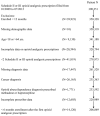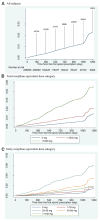Assessing risk for drug overdose in a national cohort: role for both daily and total opioid dose?
- PMID: 25486625
- PMCID: PMC4385393
- DOI: 10.1016/j.jpain.2014.11.007
Assessing risk for drug overdose in a national cohort: role for both daily and total opioid dose?
Abstract
Current research on the risk of opioid analgesics with drug overdose does not account for the total morphine equivalent dose (MED) of opioids filled by a patient. In this study, time from first opioid prescription until drug overdose was examined for 206,869 privately insured patients aged 18 to 64 with noncancer pain and ≥2 filled prescriptions for Schedule II or III opioids from January 2009 to July 2012. Opioid therapy was examined in 6-month intervals including 6 months before an overdose and categorized as mean daily MED (0, 1-19, 20-49, 50-99, ≥100 mg) and total MED divided at top quartile (0, 1-1,830, >1,830 mg). Survival analysis was used, adjusting for demographics, clinical conditions, and psychoactive drugs. Relative to no opioid therapy, persons at highest risk for overdose (adjusted hazard ratios of 2-3) received a daily MED of ≥100 mg regardless of total dose or a daily MED of 50 to 99 mg with a high total MED (>1,830 mg). The hazard ratio was significantly lower (1.43, 95% confidence interval = 1.15-1.79) for 50 to 99 mg daily MED with a lower total MED (≤1,830 mg), whereas hazard ratios for lower daily MEDs did not differ by total dose. This analysis suggests that clinicians should consider total MED to assess risk of overdose for persons prescribed 50 to 99 mg daily MED.
Perspective: When addressing risks for drug overdose, this analysis supports the need for clinicians, administrators, and policy makers to monitor not only daily opioid dose but also total dose for patients receiving 50 to 99 mg daily MED.
Keywords: Analgesics; chronic pain; dose response relationship; drug; opioid; overdose.
Published by Elsevier Inc.
Conflict of interest statement
None of the authors have any conflicts of interest or disclosures to report that purposefully or inadvertently affect the conduct, outcome, or reporting of any scholarly activity.
Figures



References
-
- Agency Medical Director's Group. Web-Base Opioid Dose Calculator. [Accessed April 7, 2014]; Available at: http://agencymeddirectors.wa.gov/mobile.html.
-
- Bohnert AS, Valenstein M, Bair MJ, Ganoczy D, McCarthy JF, Ilgen MA, Blow FC. Association between opioid prescribing patterns and opioid overdose-related deaths. JAMA. 2011;305:1315–1321. - PubMed
-
- Centers for Disease Control and Prevention: National trends in pharmaceutical opioid related overdose deaths compared to other substance related overdose deaths: 1999-2009. [Accessed April 10, 2014]; Available at: http://www.cdc.gov/media/releases/2013/p0220_drug_overdose_deaths.html. - PubMed
Publication types
MeSH terms
Substances
Grants and funding
LinkOut - more resources
Full Text Sources
Other Literature Sources

